I appreciate your comments. It is not simply, for example, just opening up the doors of the MFRC and then all of a sudden our veterans and their families can come in and take advantage of the programs that were already offered. There are fundamental differences between the military family services program that we have now and the VAC-sponsored veteran family program.
For example, our whole program is built on the three unique characteristics of military lifestyle that families endure: frequent geographical relocations; extensive separation from families; and the risk of the profession of arms, which can result in illness, injury, or death. The program is built to help the families of Canadian Armed Forces members adjust to those living conditions as they're going across Canada.
Also, note the difference in the programs. For example, the CAF member, as you know, is looked after by the Canadian Armed Forces. All of a sudden, when you take off your uniform, you don't have that care from the Canadian Armed Forces. Under the veteran family program, the veteran and the family are now included. There's a distinct difference between the MFSP and the veteran family program.
As you can see, it is now totally turned opposite. A veteran and their family no longer have geographical relocations; in fact, they're permanently located in the community wherever they may live, and we don't know that at once when they're retiring. They don't have extended absences from their family, and that, of course, can have its own issues in many cases. Thirdly, not only do they not have a risky profession anymore, they have the whole culture shock of taking off the uniform.
The veteran family program is really geared to integrating a veteran and their family into the new life that they're going to be experiencing, into their community permanently. That's going to involve all kinds of community partnerships and we're going to have to educate and inform the community of what they're receiving for the ill and injured veteran and their family.
First of all, we have to recognize that the family has its own transition. It's not necessarily always linked to the member. We have to think about the families. We plan on doing that, but specifically to answer your question, we need to link up with the releasing member and their family immediately, because all the ill and injured are posted to the IPSCs, the integrated personnel support centres. We need to get linked up, right at that starting point, as soon as a member releases as an ill and injured member. We have to continue that process straight through with the family. We do have family liaison officers under the military family services program who are integrated into the IPSCs, so they will be able to start the comprehensive analysis of the needs of the family.
The beauty of the veteran family program is that it's tailored for the specific needs of the family. It's not a matter of you coming in and taking one of these and one of those. It's “What do you need?”, and we will develop a program for you to meet those needs.





